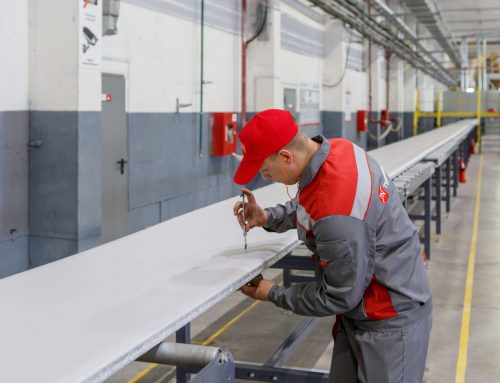When it comes to commercial construction, rigid foam insulation meets a trifecta of requirements – performance, durability and economics. Rigid foam insulation is a versatile material used in a range of applications, from vehicle manufacturing to building insulation. It is lightweight, relatively cheap, durable, long-lasting and inert (meaning it doesn’t react with other materials).
A Brief History of Rigid Foam Insulation
In the 1950s, an inventor combined polystyrene and isobutylene, inadvertently creating a foam polystyrene product. This was used immediately in flotation devices during World War II. Since then, advancements in manufacturing and quality control have diversified the application of polystyrene.
As a hard, solid plastic, it can be used in laboratory ware, automotive parts, appliances, food packaging and electronics. When it comes to building insulation, polystyrene can be made into an insulating foam material, the most common being expanded polystyrene (EPS), and extruded polystyrene (XPS).
Polystyrene Foam Materials Compared
EPS and XPS foams are both manufactured from the petroleum-based resin, a thermoplastic based on non-cross-linked polymers. EPS is commonly used in eskys, packaging, cups and takeout containers. Made of 2% plastic and 98% trapped air, EPS foam consists of tiny polystyrene beads expanded many times their original size.
XPS foam on the other hand, consists of polystyrene resin crystals combined with additives and a gas-blowing agent, continuously extruded through a machine and then cut to length. XPS foam boards are the ideal option when it comes to specifying high quality insulation for buildings, including roofing and below grade applications.
Benefits of XPS Foam for Building Insulation
XPS foam is valued for its high level of thermal efficiency and strength-to-weight ratio. This is because it features a closed-cell construction, making it highly water resistant and capable of performing well as an insulator even in the most challenging situations. The important characteristic that distinguishes it from EPS foam is that there are no tiny voids or spacing between the polystyrene cells. This is a result of the continuous extrusion production process.
Having a completely closed-cell construction is essential for reducing heat transfer and makes XPS foam highly resistant to water absorption. This gives it the unique ability to maintain low thermal conductivity in the presence of large amounts of water. For this reason, it’s specified for applications such as building foundations, underground walls, inverted roofs (including terraces and green roofs), cold storage facilities, parking lots and any other situation that requires high durability and water resistance.
High-Performance Insulation for Construction
When specified as insulation in commercial construction projects, XPS foam can save approximately 200 times the amount of its embodied energy by increasing the building envelope efficiency. It also has impressive compressive strength characteristics, allowing it to be used in load bearing floors. This is important as floors are a huge source of thermal transfer.
A closed-cell insulation material like XPS foam can resist freeze-thaw cycles, ensuring long term durability at a relatively low cost. Moisture that gets into tiny gaps of EPS foam insulation will shrink and expand as it goes through the freeze/thaw cycle. This significantly impacts its performance as an insulator on top of causing early deterioration. XPS foam insulation is water repelling and is capable of withstanding over 1000 freeze/thaw cycles.
XPS Foam Improves Energy Efficiency in Buildings
The homogeneous closed-cell composition of XPS foam insulation ensures heat transfer and air leakage is entirely prevented. This is crucial as the energy losses caused by air leaks and a poorly insulated building has a drastic impact on heating and cooling costs. In both summer and winter, properly specified XPS foam insulation boards regulate a consistent temperature inside a building, regardless if whether conditions are wet or dry.
XPS foam insulation has a consistent and predictably tested long-term thermal resistance, even in wet conditions and at low temperatures. It also maintains its thermal and mechanical performance for long periods of time, meaning it’ll continue to perform at a high standard over the life of the building. It is also able to withstand the stresses of temperature changes and freeze/thaw cycles.
Technonicol XPS Foam Insulation for Commercial Construction
Technonicol produces premium quality thermal insulation boards made of extruded polystyrene. Technonicol’s Carbon XPS foam insulation series comes in a range of sizes, thicknesses and compressive strengths to meet the demands of almost every application.
At Plastek, we have extensive experience consulting and supplying these XPS foam insulation products, helping to optimise projects by providing the ideal solutions. We can recommend the right Carbon XPS foam insulation product for your specific project, ensuring a functional and high performance solution for your building.
Related Questions
How long does XPS foam last?
XPS foam insulation is capable of lasting 100 years or more due to its rigid construction, meaning you never have to worry about replacing it.
Are rigid foam insulation boards a fire hazard?
Petroleum-based products are inherently combustible. However, insulation products manufactured by established companies must pass independent fire testing, whether it’s EPS or XPS, and be able to meet minimum safety requirements to ensure they don’t pose an unacceptable fire risk.
Is XPS foam bad for the environment?
XPS insulation can be salvaged during renovations and demolitions and is 100% recyclable. Using XPS foam insulation also contributes enormously to reducing energy use in a building. It lasts decades once installed and significantly lowers the carbon footprint of the building over its lifespan.





Leave A Comment